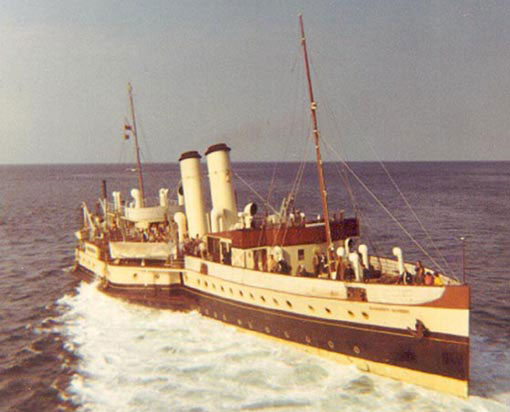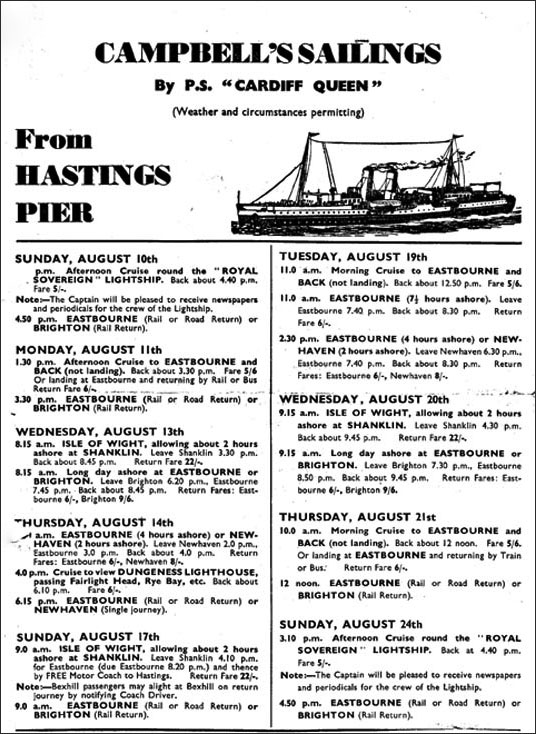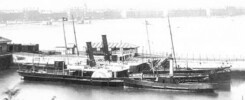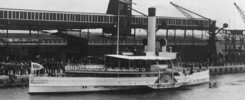
Built in 1947 for service on the Bristol Channel, P & A Campbell’s paddle steamer Cardiff Queen (pictured above) spent the summers of 1952 and 1953 on the company’s Sussex station running from Brighton, Eastbourne and Hastings on a variety of excursions between Folkestone in the east and Southampton and the Isle of Wight in the west. She did not have a Cross Channel Passenger Certificate and, in any case, no-passport trips to the continent were not permitted by the government at that stage, a circumstance which has once again become the norm today.
In 1951 P & A Campbell had abandoned their Sussex operation sending their large turbine steamer Empress Queen to try her hand at Torquay instead so it was welcome news when Cardiff Queen arrived in Newhaven on 23rd June 1952 to re-open the Sussex sailings. She remained in the area until 18th September when she set off for her winter lay up at Bristol. On both outward and return trips she called at Plymouth to take on fuel.

The range of sailings from Hastings in August 1952 makes interesting reading with some quite early starts. One wonders just how many holiday makers were able to persuade their seaside landladies to give them their breakfasts early enough to walk down to the pier in time to catch the 8.15am boat to Shanklin.
On the Sunday trips to the Royal Sovereign Lightship, the steamer notice advises that “The Captain will be pleased to receive newspapers and periodicals for the crew of the lightship”. This was a nice gesture for the lightship crew but it was also good for the onboard sales as passengers were encouraged to buy and then donate such items to the lightship.
The Sussex Coast presented various problems for excursion steamer operators. The piers at Brighton, Eastbourne and Hastings were very exposed and therefore inaccessible in windy conditions and those at Worthing and Bognor Regis were not only exposed but also only available at higher states of the tide. There were no adjacent sheltered areas so other cruises could not be substituted when the weather was bad and blank days with no sailings at all could be numerous in a season. Travelling along the coast between the resorts was more convenient by coach or train than by steamer. Whilst the scenery around Beachy Head was and is interesting, most of the Sussex Coast is rather flat and without other particularly stunning vistas. As few people were in possession of a passport in those days, Cross Channel trips were dependant on the Government allowing no-passport trips and this was a moveable feast. And there was an hour or so of light steaming each day taking the steamers back to the overnight berths at Newhaven. It is therefore not altogether surprising that Sussex Coast sailings declined earlier than those in other major excursion strongholds like the Isle of Wight and Dorset Coast, the Bristol Channel, the Clyde and the Thames.
Cardiff Queen spent a second summer on the Sussex Coast in 1953 but returned to run on the Bristol Channel in 1954, an area for which her name suited her better. Her place was taken on the Sussex Coast by the older Glen Gower, built in 1922, which did have a Cross Channel Passenger Certificate and so could take advantage of a relaxation of the no-passport regulations that year. Glen Gower lasted for just three seasons returning to the Bristol Channel to run in 1957 before being laid up and scrapped in 1960. P & A Campbell did not entirely abandon Sussex in 1957 as they chartered in the small Diesel passenger vessel Crested Eagle (not the famous paddle steamer Crested Eagle!) from the Thames but this experiment was not repeated in future years. P & A Campbell retained the booking offices at the piers and, when the company was bought out by Townsend Ferries of Dover, these same booking offices were used as a feeder selling tickets with a coach connection for the Townsend Dover to Calais Cross Channel ferry.
Cardiff Queen continued to operate on the Bristol Channel until 1966, a season dogged by accidents, breakdowns and other difficulties, after which she was withdrawn and scrapped two years later. Sharing the same year of build as our own Waverley which has now clocked up more than fifty years of service, Cardiff Queen had a short career of just twenty years, roughly the same period that Kingswear Castle has been in service since the completion of her restoration. She was a very young paddle steamer to fall under the breaker’s axe and torch.
Kingswear Castle returned to service in 2023 after the first part of a major rebuild which is designed to set her up for the next 25 years running on the River Dart. The Paddle Steamer Kingswear Castle Trust is now fund raising for the second phase of the rebuild. You can read more about the rebuilds and how you can help if you can here.
John Megoran


